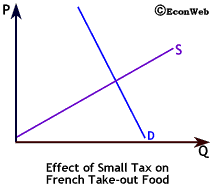
In France restaurant meals are subject to a 20.6% tax while take-out food is only taxed at a 5.5% rate. The Chefs claim this unfairly targets traditional restaurants and favors foreign fast-food businesses like McDonald's. They also claim that the tax significantly reduces restaurant employment.
As we know, the effect of a tax depends on the relative demand and supply elasticities. For our purposes it is reasonable to assume that supply elasticity is the same for restaurants and fast-food establishments. We can be equally confident in assuming that demand elasticity is very different in these two markets.
Dining in restaurants is, for most diners, a form of entertainment, something done primarily for pleasure. It is clear that there are many alternatives to restaurant dining. Restaurant meals are often very expensive, usually many times more expensive than take out and even more costly that home prepared food. On the other hand, fast-food dining, particularly for the French who are said to be embarrassed if seen patronizing a fast-food establishment, is usually seen as a necessary evil resulting from a busy schedule. In addition, such food is usually very inexpensive relative to other alternatives. For these reasons we can expect the demand for restaurant dining to be much more elastic than the demand for fast-food dining.

To the right we show the effect of a small tax on the market for fast-food. Notice that the after-tax supply curve, St has a different slope than the pre-tax supply curve, S. An ad valorem tax, such as the 5.5% tax on fast food (and sales taxes in the U.S.), is a percentage of the price so the amount of the tax is larger the higher the price.
The 5.5% tax (not shown to scale) in this inelastically demanded market causes market price to rise from the pre-tax equilibrium price of Po to the after-tax equilibrium price of Pt. The after-tax per-unit revenue for producers is Pf. We can see that most of the tax is passed along to consumers. Their per-unit burden is Pt - Po. Only a very small amount of the tax, Po - Pf is borne by firms selling fast food. The tax also doesn't reduce the quantity sold or firm revenue by very much. The quantity sold only falls from Fo to Ft. Pre-tax revenue is shown by the green shaded area while post-tax revenue is shown by the only slightly smaller purple shaded area.

To the right we show the effect of a much larger 20.6% tax on restaurant meals, which, as we noted above, have a much more elastic demand. The market price rises only slightly from the pre-tax equilibrium price of Po to the after-tax equilibrium price of Pt, but the after-tax per-unit revenue for producers is Pr, a large decrease in the pre-tax revenue per meal of Po.
One point the Chefs make is clearly borne out by this illustration. The number of restaurant meals falls a great deal from Ro to Rt. Their claim that the tax hurts employment in the restaurant industry is probably right. A large tax in a market with elastic demand leads to a large decrease in sales and, typically, a lot of lost jobs. The revenue 'hit' taken by restaurants as a result of this tax is huge as well. Pre-tax revenue is shown by the green shaded area while the much smaller post-tax revenue is shown by the much smaller purple shaded area.
We don't know what the intent of this tax originally was. Perhaps it was simply to raise revenue, which it does but, all else being equal, this could be accomplished more effectively in a market with inelastic demand. Often taxes like this, imposed on expensive luxury items such as fine dining, are meant to be a tax on the rich. If that was the purpose it seems likely that the tax failed. Both our economic analysis and egg-throwing Chefs suggest that the burden of the tax is borne not by customers of expensive restaurants, but by their owners, employees, and former employees.
Copyright © 1995-2003 OnLineTexts.com, Inc. - All Rights Reserved